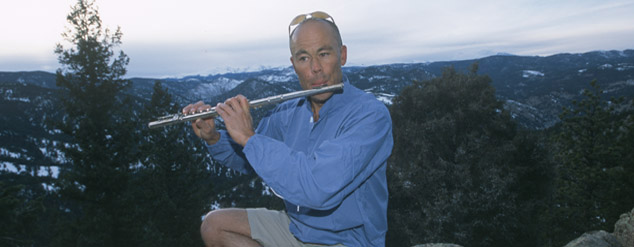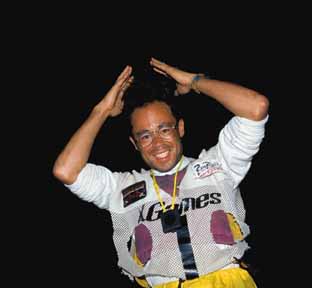
You won't see him playing smash-mouth football in some upstart, testosterone-addled pro league. Nor will you ever watch him swapping spittle and broken chairs with loutish, muscle-bound Neanderthals in "WWF Smackdown." Nor will you ever observe him lifting a mid-size Japanese import in one of those televised "Strongman" competitions. But if there ever comes a time when some organization gives out an award for "Toughest Man on the Planet," topping our list of potential nominees will be adventure athlete Ian Adamson, 36, of Boulder, Colorado.
Tipping the scales at a svelte 160 pounds, and standing a modest five feet, eight inches - bare-footed, of course - Adamson is a lean, keen, endurance machine, one of the most versatile and all-around athletes in the sport of adventure racing. Hewed from a most remarkable slice of DNA, Adamson is a perfect blend of brains and brawn, equally at home in the jungles of Borneo, where his adventure racing team, Eco-Internet, won last year's Eco-Challenge, or in the science lab, where he applied his advanced college degree in mechanical engineering to create a patented medical device for CPR. He earned a berth in "Guinness Book of World Records" for setting the world-record in marathon kayaking - 217 miles in 24 hours along the Yukon River. He also spends a lot of time in the kitchen where he is a gourmet chef. He's host of "Chevy Blazer Adventure Racer" on Outdoor Life Network. And he's the motivational speaker and instructor for Colorado Adventure Training. His other interests include: accomplished scuba diver with more than 1,000 dives, ocean sailor, Cessna pilot and trained concert flautist.
Teammate Robyn Benincasa describes Ian as: "Playmate, great pal, partner, talented beyond reason, optimistic, worldly, calm, solid, navigation God, one-in-a-million, Renaissance guy, mushball." Kinda reads like a personal ad, but sorry gals, Ian got married last fall to a registered nurse.
With consistent victories in all the major adventure races (Raid, Eco-Challenge, X-Games and Southern Traverse) Ian is now recognized as the sport's Tiger Woods. He has the same incandescent smile. And like the golf phenom, Adamson's biological parents come from different racial backgrounds; his mother is English and his father is Portuguese-Thai. While Ian has achieved deity status among adventure racers, this supremely talented multisport athlete goes about his daily training and activities with all the reserve and quiet anonymity of a zen monk. He craves globetrotting adventure for its sheer adrenalin pleasure. Granted, some of his athletic accomplishments border on sheer masochistic lunacy, such as the time he competed in a 24-hour running race on a 1/5 mile course inside a parking garage in Atlantic City, New Jersey, and went 93 miles to finish in third place. The physical muse that motivates this Mighty Mite is a child-like curiosity to visit new worlds which he explores via kayak, horseback, sailboat, outrigger canoe, foot, bicycle, ropes, skis, snowshoes or inline skates. He embodies the playful restlessness found in one of his favorite books, Dr. Seuss' "Oh, The Places That You Will Go." RailRiders snagged the always-in-motion Ian for a half-day photo shoot in Boulder just before he was traveling to India and China where he was asked to map out race courses for event organizers. With typical vaudevillian flair, Ian proved to be a natural before the camera. And if Ian seems GQ-comfortable and quite at ease in his RailRiders, well, that's because he has been wearing RailRiders clothing since 1996.
Q: You have raced all over the globe in every condition and environment possible. Borneo jungle. Patagonia ice fields. Baja desert. Himalayas. British Columbia glacier fields. Dense Maine forests. So, which is your favorite race setting, and why?
Ian Adamson: Tough question. I love all extreme climates. The endless twilight or daylight above the Arctic Circle has a certain beauty, and deserts are alluring in an exquisitely harsh manner, but it is mountain environments like the Andes that I prefer to race in. You see such dramatic scenery, and a huge variety of climates and change in the mountains you just don't get anywhere else. In the lake district of Argentina, there are glaciers, endless snow and ice fields, high peaks, lush valleys, stark alpine deserts, big rock walls, cascading streams, big rivers, and crystal-clear lakes. The air is clean and clear, you can drink the water without mortal fear and weather patterns generally allow you to dry out at some point!
Q: What is your scariest adventure racing experience. Your nastiest experience?
IA: My scariest race experience was in the Southern Traverse in FiordLand in New Zealand in 1995. Our team was climbing a small cliff and we were in too much of a hurry to use our rope, a nearly fatal mistake. I was holding onto a tree at the top of the climb and offered my hand to my teammate Robert Nagle. He lunged upwards and we joined hands, but the mud and slime from all the rotting vegetation made a handy lubricant on our skin and he slowly fell back. We had locked eyes and there was absolutely nothing we could do but watch each other as he fell backwards into the creek 20 feet below. It was like a scene from the film "Cliffhanger," with Robert's crumpled body wrapped around some rocks in the freezing water. We were fortunate that a couple of Kiwi teams happened by and helped us because Robert was in pretty bad shape.We finished the race, but he had some terrible balance problems for several months afterwards. He couldn't even sit up in bed without falling over again. The nastiest experience was in the Eco-Challenge in Patagonia in 1999. I was racing with "Las Diosas" (the three Goddesses: Robyn Benincasa, Cathy Sassin and Rebecca Rusch) and we were running down the side of Mount Tronador, trying to catch the four teams ahead of us. We could see headlamps all over the valley, so we knew we were close, but it was absolutely pitch dark and there were holes and cliffs and crevasses everywhere. Just as we hit the bottom of the valley, about 200 meters from the checkpoint, Cathy asked us to stop and look at something. She had taken a fall on the razor-sharp granite and gashed her wrist to the bone. Cathy seemed fascinated that she could move her hand around and see the tendons moving up and down like in an anatomical display model. I had her hold the wound closed and cleaned the blood off as best I could, then made butterfly sutures from duct tape. Amazingly the wound healed perfectly and she now has a hairline scar across the base of her wrist.
Q: Do you like singing songs while you race. If so, what are they?
IA: I often sing songs in the dark hours of early morning when I am profoundly tired. Actually it can be anytime I am really tired, and this can be in bright daylight towards the end of a race. Robert Nagle has the Irish skill for a tune (he is in a choral group in Boston) and can whip out some amazing songs. Unfortunately he needs to be really drunk or really tired to do this. My other teammate Robyn Benincasa also has a wonderful singing voice and a photographic memory and can remember just about every word from every TV show ever made. She had us singing X-rated "South Park" songs at full volume in Patagonia on the last paddle to the finish.
 Q: Any advice to someone doing his or her very first multi-day adventure race?
Q: Any advice to someone doing his or her very first multi-day adventure race?
IA: Probably the toughest thing in your first multi-day race is coping with the lack of sleep. As the races get longer, over about three days, sleep management becomes increasingly important. Our team, Eco-Internet, seems to need about three hours of accumulated rest in every 24- hour period over three days, and more like four hours over seven days. Under three days you can get away without sleeping at all, but it is quite difficult to pull off without making mistakes. A few other pointers: Have the team agree on its goals. Understand that racing is a dynamic situation and be flexible within the framework of how you operate. Have more than one navigator. Learn to communicate effectively, which is to understand first and be understood second.
Q: How did you become such a good paddler?
IA: I guess "good" is relative. In Australia I would be regarded a reasonable club paddler, but on the adventure racing scene that translates to quite a bit better than reasonable. Sports that have a high level of skill involved such as paddling, nordic skiing and mountain biking require a lot of time to become proficient. I spent years learning to balance a racing kayak before I got good enough to put any reasonable effort in. Many people ask me how to train for kayaking, and my answer is to put the same amount of time and effort you have already put into any other sport you are good at.
Q: Do you navigate at night by the constellations during an adventure race?
IA: Interestingly we use celestial bodies to navigate at night, if we can see them. It is much easier to aim towards a heavenly body low on the horizon than to stare at a compass. By looking into the distance your focus allows you to see and avoid obstacles you wouldn't recognize if you focus at arm's length. The one thing you need to be aware of is the rotation of the earth and the consequent change in position of the heavenly bodies with respect to your position.
Q: Who is your favorite all-time adventurer?
IA:Without doubt the greatest adventurer of all time was Sir Ernest Shackleton. For those unfamiliar with his exploits, Shackleton was a turn-of-the-century Antarctic explorer who arguably pulled off the most amazing self-rescue in history. During the voyage of the Endurance in 1914-16, his ship was trapped in the polar ice. Shackleton took his 28 men in two 20-foot open boats and sailed and drifted on the ice for 16 months to find tiny uninhabited Elephant Island. He then sailed 800 miles further in the southern ocean to South Georgia Island to get help for the crew he had left at Elephant Island. All this without loss of life and using a sextant for position with which he only made one solitary sighting through a rare break in the clouds, and in atrocious weather that routinely sinks modern-day sailing vessels.

Ian in his Weatherpants and Eco-Mesh Shirt
Q: What is one adventure you'd like to accomplish in the future, and why.
IA: I would love to explore some of the Antarctic Peninsula. Some friends of mine rented a yacht last year and sailed from Chile to the Antarctic Peninsula. They then spent three weeks skiing, mountaineering and climbing uncharted mountain ranges. This is definitely on my list. An extension of this would be to do the first non-stop human-powered circumnavigation of the globe through the poles. People have done it in pieces and using motorized vehicles, but no one has done the whole enchilada under his own steam.
Q: So, how do you think you'd have fared on "Survivor" show? And why don't we see any adventure racers on the show since the executive producer, Mark Burnett, is the founder of the Eco-Challenge?
IA: The first "Survivor" would have been quite fun. I spent several years in the tropics fending for myself. When I was 18, I sailed for nine months with my younger sister along the Great Barrier Reef. We ate mostly fish which we caught ourselves, beans and sprouts that we grew in jars, and fruit and coconuts off the trees. When I was talking about the show to Mark Burnett years before it was televised, he pretty much said that 'we', meaning adventure racers, would not be selected because we have too many team and outdoor skills.
Q: What is your typical week of training?
IA: I do a little of everything in a week. Ideally this includes speed work, strength training, skills and long endurance in each of the core sports - running, mountain biking and paddling. I also throw a few weights around for general all-around strength, and toss in a few peripheral activities like in-line skating, skiing and climbing. Most of my really long endurance comes from races or from long weekend hikes or ski trips.
Q: Any personal comments about your continued use of RailRiders?
IA: I was most unhappy in Borneo when we entered the trekking section on day four of the Eco-Challenge. We were being hotly pursued by Spie and Team Aussie and the sun was really scorching as it approached its zenith. In a fit of racing zeal, I attempted to cut the legs off my Weatherpants in order to run faster. I had raced in these trusty duds in every expedition race since the 1996 ESPN X-Games, including four Eco-Challenges, two Raid Gauloises, an Elf Authentic Adventure and two Southern Traverses. Despite their years of continued abuse, they still held up to the knife a little too well, and I found myself hopping on one foot as I tried desperately to relieve myself of a pant leg that was tenaciously hanging on by its remarkably strong fabric. The premature death of these trousers ended their 3,000-mile journey sliding down scree slopes, fording rivers and forging through some of the most abominable jungles I never want to see again.
As for other RailRiders products, I have one item of clothing that fits form, function and fashion. I am relentlessly stopped in the street by curious passersby who want to know where I got this cool shirt. This piece of apparel is my Eco-Mesh Shirt. It by far the best hot-weather expedition top I own, but can be worn on the town as well. The urban-adventurer version has even more class. I wore my white Adventure Top on my wedding day. This was not your average wedding, since we were outside on a Colorado mountaintop surrounded by Gore-Tex and fleece-clad friends. I recently took my Rampage Shorts on a short tour of Asia and the Pacific Rim. First stop was Japan for a Salomon X-Adventure World Cup race. The nice thing about these Shorts is that they are cool, chafe-free and allow you to run. My next stop was China, where I was technical director of the Mild Seven Outdoor Quest adventure race. I used my Shorts again, this time to carry notes, GPS, radio and food in the pockets - no pack necessary! In New Zealand our Team Eco-Internet raced the Discovery Channel Southern Traverse, and of course, the Rampage Shorts were invaluable scrambling through the tougher sections of the course. Finally, the Shorts and I ended up in Australia for a little hiking, biking, climbing and sailing. The Supplex material is highly wear-resistant, cool and fast-drying, essential for the abrasive damp environment of a sailing boat.
Q: Finally, if you were marooned on a desert island, what books, CDs and movies would you bring along (assuming you have batteries!)?
IA: Dr. Seuss's "The Places You Will Go," "War and Peace," "Encyclopedia Britannica," Pink Floyd's "Dark Side of the Moon," Mozart's "Symphony No. 2 in C Major," Elton John's "Classic Hits," "Monty Python and the Holy Grail," and my flute and the music for Mozart's "Flute Concerto No. 2, which I never mastered.



